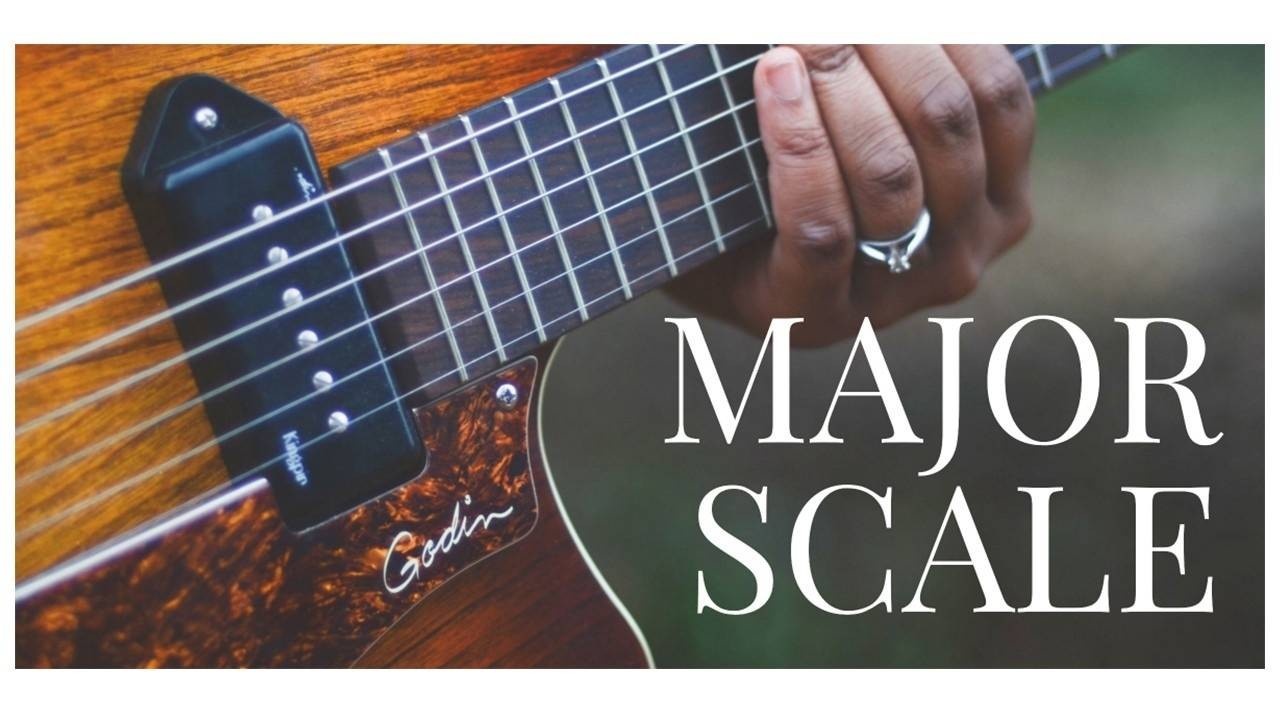
Major Scale
Feb 01, 2015The major scale is the most commonly used scale in Western music, and is the foundation of many of the melodies and progressions used in classic jazz standards.
In terms of whole steps and half steps, the formula for a major scale can be defined as: W W H W W W H. Sometimes, it is also referred by its modal name, "Ionian".
C major scale:
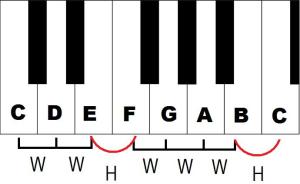
Why Learn The Major Scale?
There are many benefits to learning and practicing the major scale, both on and off the guitar. One very practical use this is to have a better knowledge of the fretboard. This is an invaluable skill to have when analyzing chord voicings, or writing music in standard notation.
Additionally, the major scale can be a useful vehicle for improving your technique, and learning how to improvise.
You'll also develop an understanding of basic music theory by studying the major scale. This includes scale theory, how chords are built, how chords relate to scales, and more.
In each of the sections below we'll explore each of these topics. This is meant as an in-depth reference page. If you're looking for a more practical, quick look at the major scale please check out our Jazz Guitar Toolbox series!
Practical Exercises
Scale Patterns: Vertical and Horizontal
There are many, many different systems for playing the major scale on the guitar. This can make it quite confusing for beginners!
The system I'm going to recommend below is designed specifically for jazz improvising. The end goal of practicing this is to be able to play in any key, in any area of the fretboard.
To achieve this, we'll practice the major scale in 2 ways: vertically and horizontally.
Vertical Scale Patterns
Here are seven vertical patterns for the major scale: one starting on each note. Pattern 1 starts on the first note of the scale, Pattern 2 starts on the second note of the scale, and so on.
These are commonly referred to as modes, but for now, just think of it as seven different ways to play the given notes of any major scale. For this reason, I've chosen to omit their modal names in this lesson.
All of the patterns start from the sixth string, and the white dots in each scale pattern indicate the root of the scale. I recommend starting with the middle finger of the left hand for all the patterns, except for pattern 7 where I usually start with the ring finger.
Pattern 1
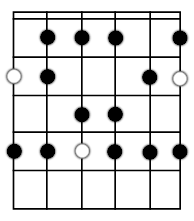
Pattern 2
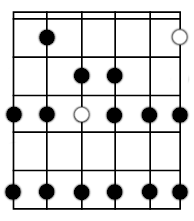
Pattern 3
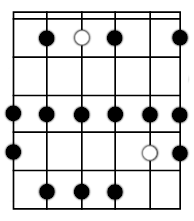
Pattern 4
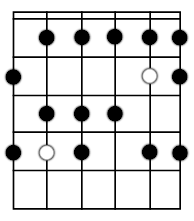
Pattern 5
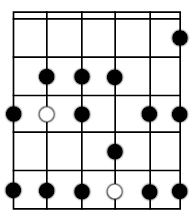
Pattern 6

Pattern 7

Horizontal Scale Patterns
Once you've memorized the 7 scale patterns above, the next step is to practice each scale horizontally. In practical terms, this means playing on 1 string in each key.
For example, play the E major scale on the 6th string:
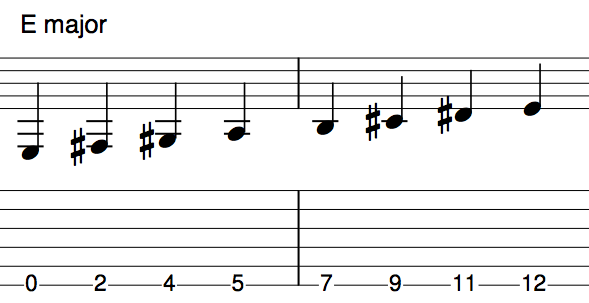
Pick a random key and a random string (you can use cue cards for this) and practice playing the scale ascending and descending. You can also try improvising over top of a drone!
Note: this is much easier once you've grasped the theory in the second half of this lesson, and have memorized the notes in each major scale.
For further ideas on this concept I recommend checking out Mick Goodrick's classic book, The Advancing Guitarist.
Going Further: Improvised Scale Fingerings
Once you've mastered both vertical and horizontal scale patterns, the final step is to test yourself by improvising a scale fingering.
Pick a random major scale and practice ascending and descending, but try to intentionally avoid the patterns from before.
If you're able to do this, you've passed the test: you're able to visualize the scale and play it across the entire fretboard.
Technical Exercises & Improvising
Much like classical musicians, jazz musicians use the major scale as a vehicle to develop their technique and musicality. Here are some practical exercises you can try:
- Long tones: play one note per click, 10bpm-30bpm
- Eighth notes: swung and even eighths, 100-140bpm
- Play in diatonic thirds
- Play through each pattern using hammer-ons and pull-offs (legato)
- Strum the tonic chord (ex C for C major). Sing a melody in the key, and then try to replicate it on your guitar.
- Improvise against a drone
- Improvise on a backing track
- Improvise on a jazz standard! Something in mostly one key, like Autumn Leaves, would be a good place to start.
Major Scale Theory
There are two formulas that you need to consider when learning the major scale: the scale formula, and the order of the diatonic chords.
Major Scale Formula
Each major scale, regardless of the root, is constructed using the same formula. In whole steps (W) and half steps (H), this formula is:
W W H W W W H
note: a "whole step" is the distance of two semitones, and a "half step" is one semitone.
Don't just take my word for it, try it yourself! An easy way to understand this would be looking at a scale like F major, on one string. As you play through this, say aloud: "whole whole half, whole whole whole half".
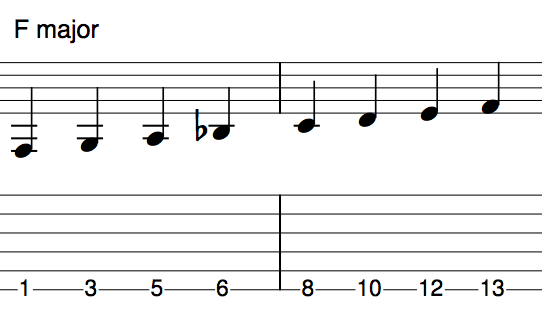
Using this formula, you can generate the notes of all twelve major scales. I've written them all out here for your reference:
- C major: C D E F G A B
- G major: G A B C D E F#
- D major: D E F# G A B C#
- A major: A B C# D E F# G#
- E major: E F# G# A B C# D#
- B major: B C# D# E F# G# A#
- F# major: F# G# A# B C# D# E#
- C# major: C# D# E# F# G# A# B#
- F major: F G A Bb C D E
- Bb major: Bb C D Eb F G A
- Eb major: Eb F G Ab Bb C D
- Ab major: Ab Bb C Db Eb F G
- Db major: Db Eb F Gb Ab Bb C
- Gb major: Gb Ab Bb Cb Db Eb Fb
note: there are 14 due to enharmonic equivalents1 (F# and Gb, C# and Db)
Diatonic Chords of the Major Scale
Each scale contains a vast number of possible chords created by combining the available notes. These are called diatonic chords: chords that naturally occur in the key.
The most common diatonic chords are built by stacking thirds to build triads or seventh chords.
Triads
By stacking two thirds, you get a triad. Here we've built a triad on each degree of the C major scale:

The chord quality for each degree (indicated by roman numeral) holds true for any major scale. That means you can memorize the order of the chord qualities like a formula.
- I = major
- ii = minor
- iii = minor
- IV = major
- V = major
- vi = minor
- vii° = diminished
Test yourself: what is the diatonic triad built on the 6th degree of the Ab major scale? 2
Seventh Chords
If you stack another third on top of the triad, you get a four note chord that is reffered to as a seventh chord. If you've looked at any jazz chord charts, then this will be familiar!
Here are the diatonic seventh chords of the C major scale:

Like the triads, the order of chord qualities is consistent in any key and should be memorized:
- I = major 7
- ii = minor 7
- iii = minor 7
- IV = major 7
- V = dominant 7
- vi = minor 7
- vii = minor 7b5 or "half-diminished"
Test yourself: what is the diatonic seventh chord built on the 4th degree of the D major scale? 3
In Summary
This can be an overwhelming amount of information to anyone looking at the major scale for the first time! Again, take a look at this Jazz Guitar Toolbox Lesson for a more practical version of this information.
Spend as much time as you need with the major scale before learning any others. The info here is the foundation for understanding other scale formulas, modes, harmonic analysis... so learn it thoroughly!
2. Answer: F minor









